Leadership in Clinical Practice: Theories, Styles, and Applications
VerifiedAdded on 2023/04/21
|8
|2214
|137
Essay
AI Summary
This essay provides an in-depth exploration of leadership theories and styles within the context of clinical practice. It begins by emphasizing the importance of flexibility in clinical leadership and discusses various theories, including the trait theory, behavioral theory, and contingency theory. The essay also addresses the relationship between leadership and management in clinical settings, highlighting the significance of patient-centered care and government influence. Furthermore, it examines transformational and democratic leadership styles and their application in different clinical scenarios, such as pediatric and geriatric cases, as well as acute and chronic conditions. The conclusion emphasizes the need for versatile and adaptable leadership to ensure effective coordination of activities and care services, promoting health-seeking behaviors and participation in care provision. Desklib offers a platform to access this essay and many other solved assignments.

Leadership in clinical practice 1
LEADERSHIP IN CLINICAL PRACTICE
Student’s Name
Institutional Affiliation
LEADERSHIP IN CLINICAL PRACTICE
Student’s Name
Institutional Affiliation
Paraphrase This Document
Need a fresh take? Get an instant paraphrase of this document with our AI Paraphraser
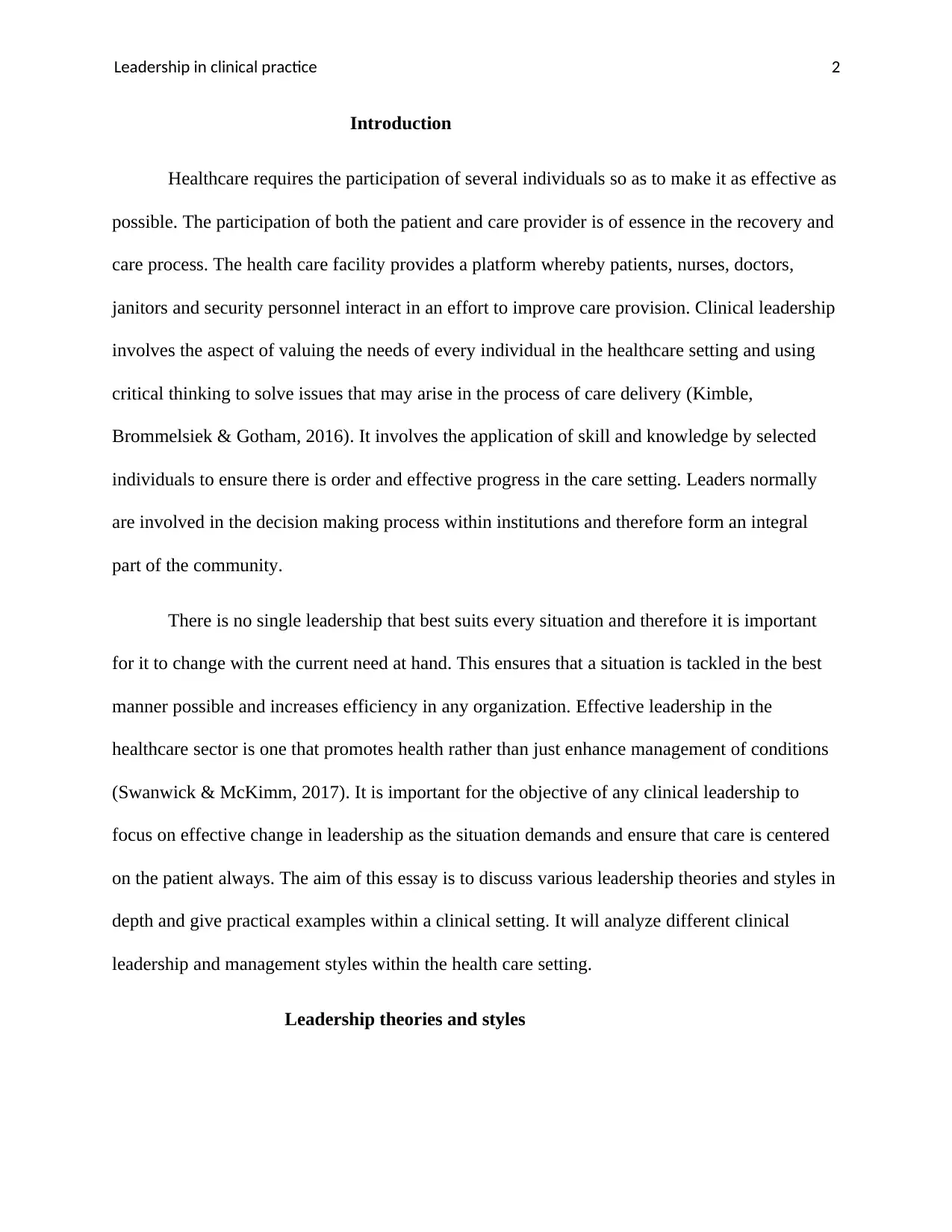
Leadership in clinical practice 2
Introduction
Healthcare requires the participation of several individuals so as to make it as effective as
possible. The participation of both the patient and care provider is of essence in the recovery and
care process. The health care facility provides a platform whereby patients, nurses, doctors,
janitors and security personnel interact in an effort to improve care provision. Clinical leadership
involves the aspect of valuing the needs of every individual in the healthcare setting and using
critical thinking to solve issues that may arise in the process of care delivery (Kimble,
Brommelsiek & Gotham, 2016). It involves the application of skill and knowledge by selected
individuals to ensure there is order and effective progress in the care setting. Leaders normally
are involved in the decision making process within institutions and therefore form an integral
part of the community.
There is no single leadership that best suits every situation and therefore it is important
for it to change with the current need at hand. This ensures that a situation is tackled in the best
manner possible and increases efficiency in any organization. Effective leadership in the
healthcare sector is one that promotes health rather than just enhance management of conditions
(Swanwick & McKimm, 2017). It is important for the objective of any clinical leadership to
focus on effective change in leadership as the situation demands and ensure that care is centered
on the patient always. The aim of this essay is to discuss various leadership theories and styles in
depth and give practical examples within a clinical setting. It will analyze different clinical
leadership and management styles within the health care setting.
Leadership theories and styles
Introduction
Healthcare requires the participation of several individuals so as to make it as effective as
possible. The participation of both the patient and care provider is of essence in the recovery and
care process. The health care facility provides a platform whereby patients, nurses, doctors,
janitors and security personnel interact in an effort to improve care provision. Clinical leadership
involves the aspect of valuing the needs of every individual in the healthcare setting and using
critical thinking to solve issues that may arise in the process of care delivery (Kimble,
Brommelsiek & Gotham, 2016). It involves the application of skill and knowledge by selected
individuals to ensure there is order and effective progress in the care setting. Leaders normally
are involved in the decision making process within institutions and therefore form an integral
part of the community.
There is no single leadership that best suits every situation and therefore it is important
for it to change with the current need at hand. This ensures that a situation is tackled in the best
manner possible and increases efficiency in any organization. Effective leadership in the
healthcare sector is one that promotes health rather than just enhance management of conditions
(Swanwick & McKimm, 2017). It is important for the objective of any clinical leadership to
focus on effective change in leadership as the situation demands and ensure that care is centered
on the patient always. The aim of this essay is to discuss various leadership theories and styles in
depth and give practical examples within a clinical setting. It will analyze different clinical
leadership and management styles within the health care setting.
Leadership theories and styles

Leadership in clinical practice 3
Flexibility in clinical leadership is an important aspect that ensures every situation is
dealt with in the best way possible to ensure productive outcomes (Jun, Kovner & Stimpfel,
2016). There are many different theories that have been put in place over time to explain
leadership and explore the application of leadership in institutions and organizations in the world
today. The definition of a good leader remains debatable over time as many people have different
perspectives on the qualities of a leader. The theories developed by psychologists have sought to
bring light in understanding who a true leader is and the traits they should possess. Some theories
for example state that a leader is born while others define a leader as made overtime by exposure
to situations that mold them to become leaders. This subject still remains debatable with
examples of leaders in the world today.
The trait theory that was developed in the 1930s define a leader as someone who
possesses specific character traits that make him or her most suitable to lead others. It focusses
mainly on the display of a person’s character. The behavioral theory on the other hand was
instituted in the 1940s and describes a leader to be someone whose behavior depicts their
leadership skills. The contingency theory depicts that there is no leadership style that best suits
all situation. According to Webb (2016), it states that there is need for change in leadership styles
so as to suit a particular situation at hand. Leadership is therefore defined with how a person
handles a particular situation at hand effectively. This involves someone fit to be a leader to
engage in critical thinking in order to come up with the best solution for a particular situation.
The leader in this theory is shaped by interaction with the traits he or she already possesses and
the environment that deems them to make decisions depending on the current situation.
Leadership and management in clinical practice are inseparable. According to
Reichenpfader et al. (2015), to be a good leader, one must also learn to be a good manager.
Flexibility in clinical leadership is an important aspect that ensures every situation is
dealt with in the best way possible to ensure productive outcomes (Jun, Kovner & Stimpfel,
2016). There are many different theories that have been put in place over time to explain
leadership and explore the application of leadership in institutions and organizations in the world
today. The definition of a good leader remains debatable over time as many people have different
perspectives on the qualities of a leader. The theories developed by psychologists have sought to
bring light in understanding who a true leader is and the traits they should possess. Some theories
for example state that a leader is born while others define a leader as made overtime by exposure
to situations that mold them to become leaders. This subject still remains debatable with
examples of leaders in the world today.
The trait theory that was developed in the 1930s define a leader as someone who
possesses specific character traits that make him or her most suitable to lead others. It focusses
mainly on the display of a person’s character. The behavioral theory on the other hand was
instituted in the 1940s and describes a leader to be someone whose behavior depicts their
leadership skills. The contingency theory depicts that there is no leadership style that best suits
all situation. According to Webb (2016), it states that there is need for change in leadership styles
so as to suit a particular situation at hand. Leadership is therefore defined with how a person
handles a particular situation at hand effectively. This involves someone fit to be a leader to
engage in critical thinking in order to come up with the best solution for a particular situation.
The leader in this theory is shaped by interaction with the traits he or she already possesses and
the environment that deems them to make decisions depending on the current situation.
Leadership and management in clinical practice are inseparable. According to
Reichenpfader et al. (2015), to be a good leader, one must also learn to be a good manager.
⊘ This is a preview!⊘
Do you want full access?
Subscribe today to unlock all pages.

Trusted by 1+ million students worldwide

Leadership in clinical practice 4
However, in recent studies, many have tried to separate the two by claiming that the two possess
different qualities and responsibility. Whilst leadership is more seen in decision making
processes of an organization, management on the other hand involves planning and
implementation of several activities within the organization (Chavez, 2017). In clinical practice,
all physician and care providers are leaders as they are involved in decision making of a
particular care provision to their patients.
Good leadership in a clinical setting focuses on the patient needs and attends to them in
the most effective and efficient manner possible (Mannix, Wilkes & Daly, 2015). Physicians
should always listen to their patients and offer care in a polite manner. A patient-centered care
provision depicts better care outcomes as opposed to the care provider- centric care provision
that discourages patient participation. There are various laws and regulations that govern the
healthcare sector. The government is involved in healthcare by ensuring that this laws are keenly
followed in an attempt to ensure better care outcome. They ensure that ethical issues are
observed by healthcare givers hence influencing leadership in the clinical practice.
Government’s influence in clinical leadership
The government also is involved in the appointment of leaders in public health care
facilities. This leaders are mostly health care professionals as they have a better understanding of
the health care setting hence suitable to bring change within the institutions. This echoes the
contingency theory whereby good leadership is best shaped by the environment. The chief
executive officer of a certain health care facility who is a healthcare practitioner will probably
display better leadership skills as compared to an engineer in the same office. This is because
they have a better understanding of the health care setting. For good leadership to be
experienced, there is need for inclusive participation of every individual in the care practice
However, in recent studies, many have tried to separate the two by claiming that the two possess
different qualities and responsibility. Whilst leadership is more seen in decision making
processes of an organization, management on the other hand involves planning and
implementation of several activities within the organization (Chavez, 2017). In clinical practice,
all physician and care providers are leaders as they are involved in decision making of a
particular care provision to their patients.
Good leadership in a clinical setting focuses on the patient needs and attends to them in
the most effective and efficient manner possible (Mannix, Wilkes & Daly, 2015). Physicians
should always listen to their patients and offer care in a polite manner. A patient-centered care
provision depicts better care outcomes as opposed to the care provider- centric care provision
that discourages patient participation. There are various laws and regulations that govern the
healthcare sector. The government is involved in healthcare by ensuring that this laws are keenly
followed in an attempt to ensure better care outcome. They ensure that ethical issues are
observed by healthcare givers hence influencing leadership in the clinical practice.
Government’s influence in clinical leadership
The government also is involved in the appointment of leaders in public health care
facilities. This leaders are mostly health care professionals as they have a better understanding of
the health care setting hence suitable to bring change within the institutions. This echoes the
contingency theory whereby good leadership is best shaped by the environment. The chief
executive officer of a certain health care facility who is a healthcare practitioner will probably
display better leadership skills as compared to an engineer in the same office. This is because
they have a better understanding of the health care setting. For good leadership to be
experienced, there is need for inclusive participation of every individual in the care practice
Paraphrase This Document
Need a fresh take? Get an instant paraphrase of this document with our AI Paraphraser
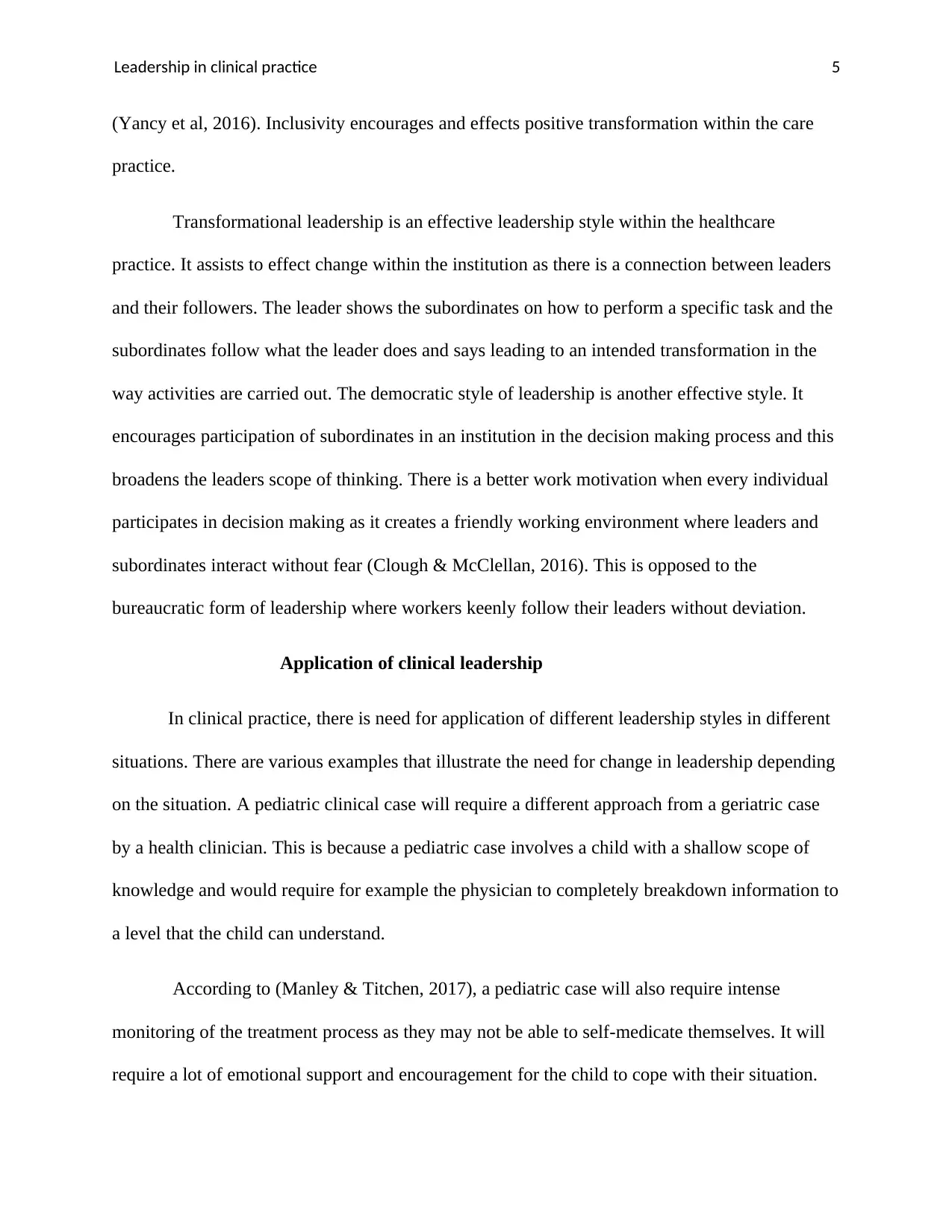
Leadership in clinical practice 5
(Yancy et al, 2016). Inclusivity encourages and effects positive transformation within the care
practice.
Transformational leadership is an effective leadership style within the healthcare
practice. It assists to effect change within the institution as there is a connection between leaders
and their followers. The leader shows the subordinates on how to perform a specific task and the
subordinates follow what the leader does and says leading to an intended transformation in the
way activities are carried out. The democratic style of leadership is another effective style. It
encourages participation of subordinates in an institution in the decision making process and this
broadens the leaders scope of thinking. There is a better work motivation when every individual
participates in decision making as it creates a friendly working environment where leaders and
subordinates interact without fear (Clough & McClellan, 2016). This is opposed to the
bureaucratic form of leadership where workers keenly follow their leaders without deviation.
Application of clinical leadership
In clinical practice, there is need for application of different leadership styles in different
situations. There are various examples that illustrate the need for change in leadership depending
on the situation. A pediatric clinical case will require a different approach from a geriatric case
by a health clinician. This is because a pediatric case involves a child with a shallow scope of
knowledge and would require for example the physician to completely breakdown information to
a level that the child can understand.
According to (Manley & Titchen, 2017), a pediatric case will also require intense
monitoring of the treatment process as they may not be able to self-medicate themselves. It will
require a lot of emotional support and encouragement for the child to cope with their situation.
(Yancy et al, 2016). Inclusivity encourages and effects positive transformation within the care
practice.
Transformational leadership is an effective leadership style within the healthcare
practice. It assists to effect change within the institution as there is a connection between leaders
and their followers. The leader shows the subordinates on how to perform a specific task and the
subordinates follow what the leader does and says leading to an intended transformation in the
way activities are carried out. The democratic style of leadership is another effective style. It
encourages participation of subordinates in an institution in the decision making process and this
broadens the leaders scope of thinking. There is a better work motivation when every individual
participates in decision making as it creates a friendly working environment where leaders and
subordinates interact without fear (Clough & McClellan, 2016). This is opposed to the
bureaucratic form of leadership where workers keenly follow their leaders without deviation.
Application of clinical leadership
In clinical practice, there is need for application of different leadership styles in different
situations. There are various examples that illustrate the need for change in leadership depending
on the situation. A pediatric clinical case will require a different approach from a geriatric case
by a health clinician. This is because a pediatric case involves a child with a shallow scope of
knowledge and would require for example the physician to completely breakdown information to
a level that the child can understand.
According to (Manley & Titchen, 2017), a pediatric case will also require intense
monitoring of the treatment process as they may not be able to self-medicate themselves. It will
require a lot of emotional support and encouragement for the child to cope with their situation.
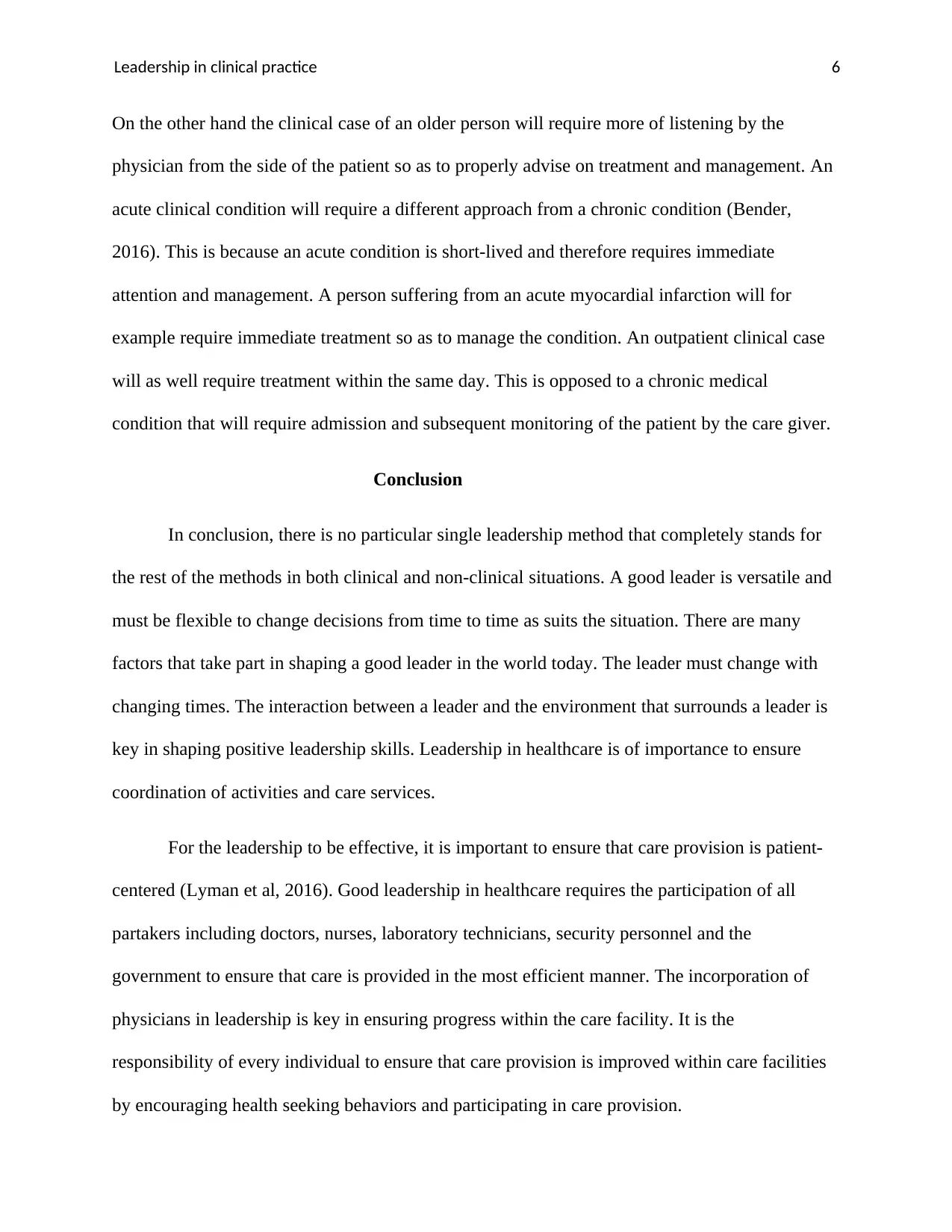
Leadership in clinical practice 6
On the other hand the clinical case of an older person will require more of listening by the
physician from the side of the patient so as to properly advise on treatment and management. An
acute clinical condition will require a different approach from a chronic condition (Bender,
2016). This is because an acute condition is short-lived and therefore requires immediate
attention and management. A person suffering from an acute myocardial infarction will for
example require immediate treatment so as to manage the condition. An outpatient clinical case
will as well require treatment within the same day. This is opposed to a chronic medical
condition that will require admission and subsequent monitoring of the patient by the care giver.
Conclusion
In conclusion, there is no particular single leadership method that completely stands for
the rest of the methods in both clinical and non-clinical situations. A good leader is versatile and
must be flexible to change decisions from time to time as suits the situation. There are many
factors that take part in shaping a good leader in the world today. The leader must change with
changing times. The interaction between a leader and the environment that surrounds a leader is
key in shaping positive leadership skills. Leadership in healthcare is of importance to ensure
coordination of activities and care services.
For the leadership to be effective, it is important to ensure that care provision is patient-
centered (Lyman et al, 2016). Good leadership in healthcare requires the participation of all
partakers including doctors, nurses, laboratory technicians, security personnel and the
government to ensure that care is provided in the most efficient manner. The incorporation of
physicians in leadership is key in ensuring progress within the care facility. It is the
responsibility of every individual to ensure that care provision is improved within care facilities
by encouraging health seeking behaviors and participating in care provision.
On the other hand the clinical case of an older person will require more of listening by the
physician from the side of the patient so as to properly advise on treatment and management. An
acute clinical condition will require a different approach from a chronic condition (Bender,
2016). This is because an acute condition is short-lived and therefore requires immediate
attention and management. A person suffering from an acute myocardial infarction will for
example require immediate treatment so as to manage the condition. An outpatient clinical case
will as well require treatment within the same day. This is opposed to a chronic medical
condition that will require admission and subsequent monitoring of the patient by the care giver.
Conclusion
In conclusion, there is no particular single leadership method that completely stands for
the rest of the methods in both clinical and non-clinical situations. A good leader is versatile and
must be flexible to change decisions from time to time as suits the situation. There are many
factors that take part in shaping a good leader in the world today. The leader must change with
changing times. The interaction between a leader and the environment that surrounds a leader is
key in shaping positive leadership skills. Leadership in healthcare is of importance to ensure
coordination of activities and care services.
For the leadership to be effective, it is important to ensure that care provision is patient-
centered (Lyman et al, 2016). Good leadership in healthcare requires the participation of all
partakers including doctors, nurses, laboratory technicians, security personnel and the
government to ensure that care is provided in the most efficient manner. The incorporation of
physicians in leadership is key in ensuring progress within the care facility. It is the
responsibility of every individual to ensure that care provision is improved within care facilities
by encouraging health seeking behaviors and participating in care provision.
⊘ This is a preview!⊘
Do you want full access?
Subscribe today to unlock all pages.

Trusted by 1+ million students worldwide
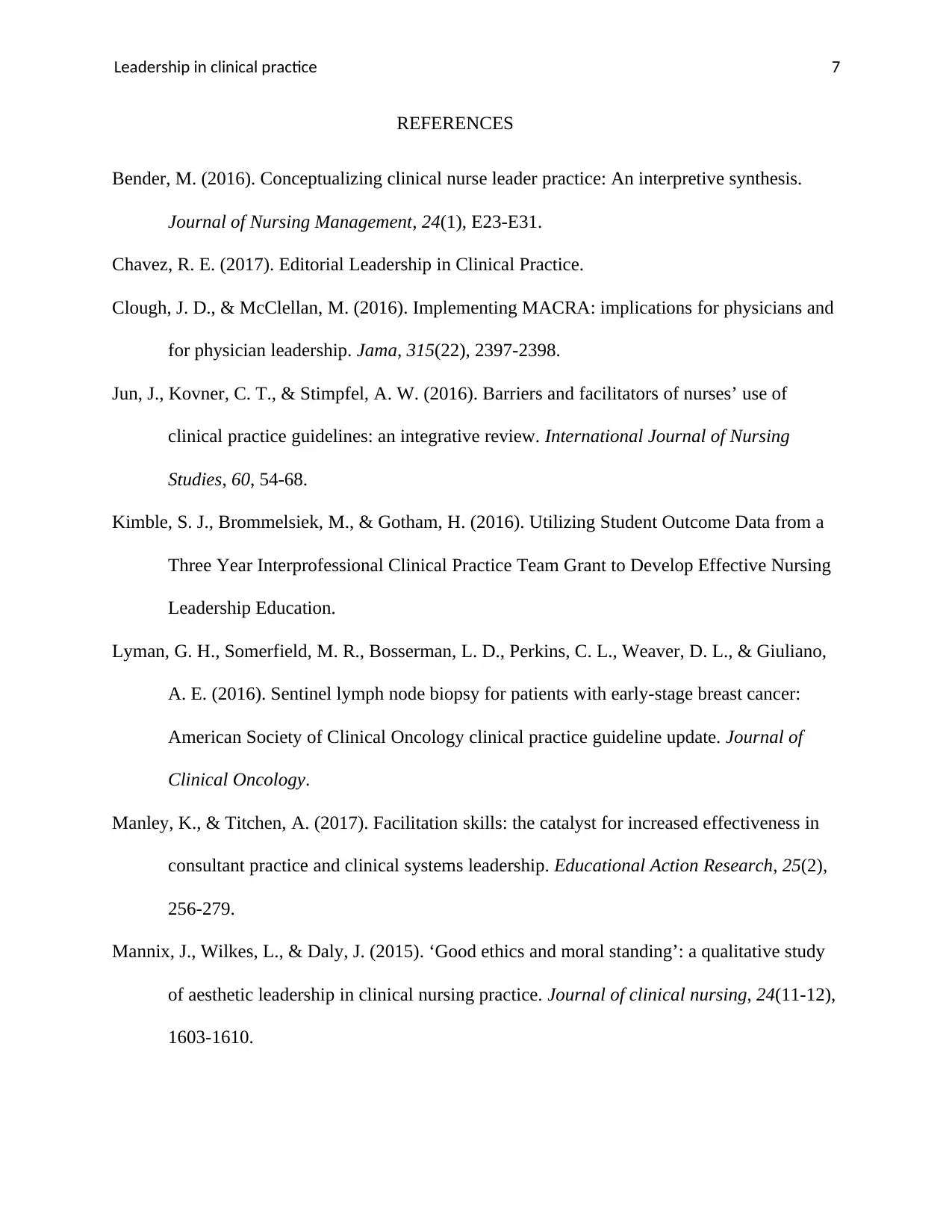
Leadership in clinical practice 7
REFERENCES
Bender, M. (2016). Conceptualizing clinical nurse leader practice: An interpretive synthesis.
Journal of Nursing Management, 24(1), E23-E31.
Chavez, R. E. (2017). Editorial Leadership in Clinical Practice.
Clough, J. D., & McClellan, M. (2016). Implementing MACRA: implications for physicians and
for physician leadership. Jama, 315(22), 2397-2398.
Jun, J., Kovner, C. T., & Stimpfel, A. W. (2016). Barriers and facilitators of nurses’ use of
clinical practice guidelines: an integrative review. International Journal of Nursing
Studies, 60, 54-68.
Kimble, S. J., Brommelsiek, M., & Gotham, H. (2016). Utilizing Student Outcome Data from a
Three Year Interprofessional Clinical Practice Team Grant to Develop Effective Nursing
Leadership Education.
Lyman, G. H., Somerfield, M. R., Bosserman, L. D., Perkins, C. L., Weaver, D. L., & Giuliano,
A. E. (2016). Sentinel lymph node biopsy for patients with early-stage breast cancer:
American Society of Clinical Oncology clinical practice guideline update. Journal of
Clinical Oncology.
Manley, K., & Titchen, A. (2017). Facilitation skills: the catalyst for increased effectiveness in
consultant practice and clinical systems leadership. Educational Action Research, 25(2),
256-279.
Mannix, J., Wilkes, L., & Daly, J. (2015). ‘Good ethics and moral standing’: a qualitative study
of aesthetic leadership in clinical nursing practice. Journal of clinical nursing, 24(11-12),
1603-1610.
REFERENCES
Bender, M. (2016). Conceptualizing clinical nurse leader practice: An interpretive synthesis.
Journal of Nursing Management, 24(1), E23-E31.
Chavez, R. E. (2017). Editorial Leadership in Clinical Practice.
Clough, J. D., & McClellan, M. (2016). Implementing MACRA: implications for physicians and
for physician leadership. Jama, 315(22), 2397-2398.
Jun, J., Kovner, C. T., & Stimpfel, A. W. (2016). Barriers and facilitators of nurses’ use of
clinical practice guidelines: an integrative review. International Journal of Nursing
Studies, 60, 54-68.
Kimble, S. J., Brommelsiek, M., & Gotham, H. (2016). Utilizing Student Outcome Data from a
Three Year Interprofessional Clinical Practice Team Grant to Develop Effective Nursing
Leadership Education.
Lyman, G. H., Somerfield, M. R., Bosserman, L. D., Perkins, C. L., Weaver, D. L., & Giuliano,
A. E. (2016). Sentinel lymph node biopsy for patients with early-stage breast cancer:
American Society of Clinical Oncology clinical practice guideline update. Journal of
Clinical Oncology.
Manley, K., & Titchen, A. (2017). Facilitation skills: the catalyst for increased effectiveness in
consultant practice and clinical systems leadership. Educational Action Research, 25(2),
256-279.
Mannix, J., Wilkes, L., & Daly, J. (2015). ‘Good ethics and moral standing’: a qualitative study
of aesthetic leadership in clinical nursing practice. Journal of clinical nursing, 24(11-12),
1603-1610.
Paraphrase This Document
Need a fresh take? Get an instant paraphrase of this document with our AI Paraphraser
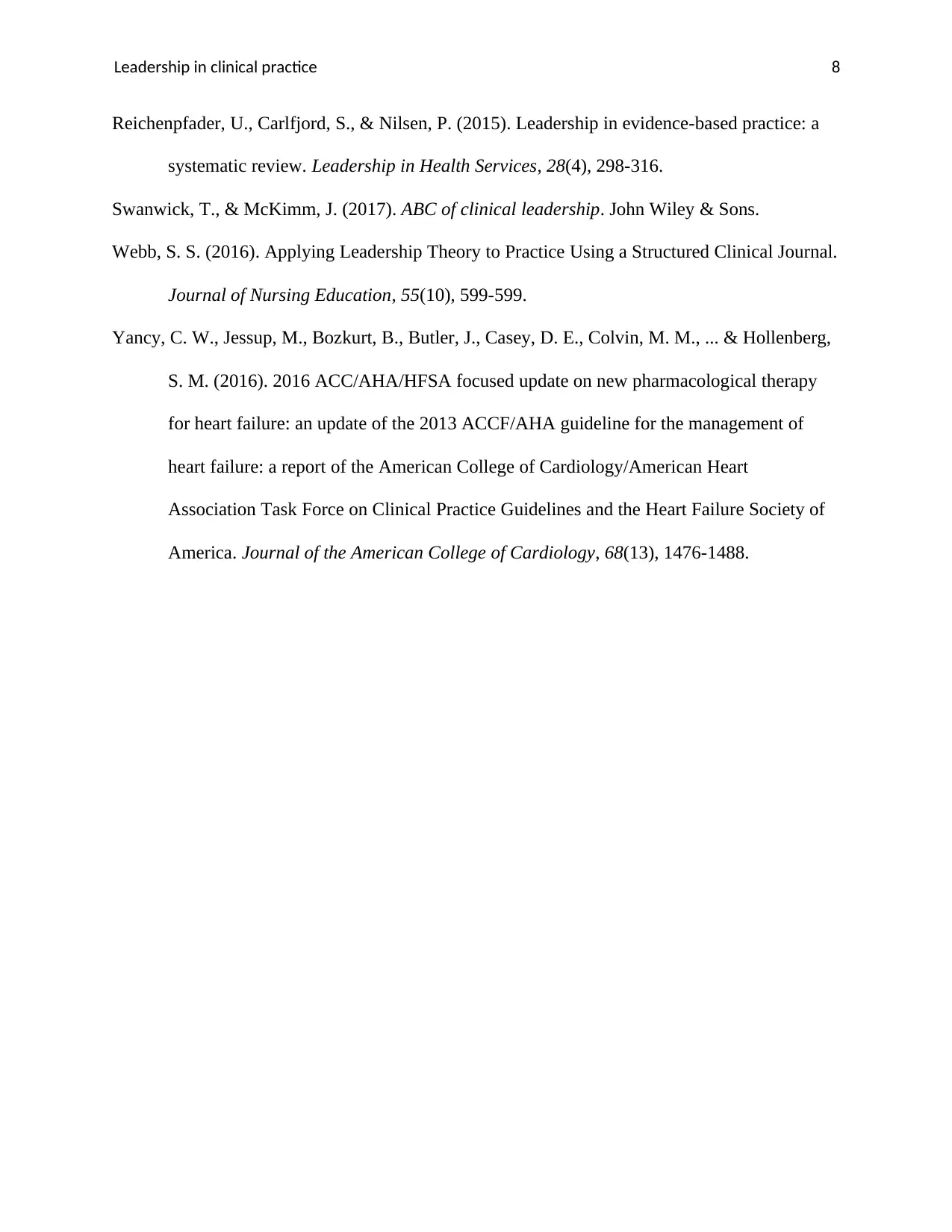
Leadership in clinical practice 8
Reichenpfader, U., Carlfjord, S., & Nilsen, P. (2015). Leadership in evidence-based practice: a
systematic review. Leadership in Health Services, 28(4), 298-316.
Swanwick, T., & McKimm, J. (2017). ABC of clinical leadership. John Wiley & Sons.
Webb, S. S. (2016). Applying Leadership Theory to Practice Using a Structured Clinical Journal.
Journal of Nursing Education, 55(10), 599-599.
Yancy, C. W., Jessup, M., Bozkurt, B., Butler, J., Casey, D. E., Colvin, M. M., ... & Hollenberg,
S. M. (2016). 2016 ACC/AHA/HFSA focused update on new pharmacological therapy
for heart failure: an update of the 2013 ACCF/AHA guideline for the management of
heart failure: a report of the American College of Cardiology/American Heart
Association Task Force on Clinical Practice Guidelines and the Heart Failure Society of
America. Journal of the American College of Cardiology, 68(13), 1476-1488.
Reichenpfader, U., Carlfjord, S., & Nilsen, P. (2015). Leadership in evidence-based practice: a
systematic review. Leadership in Health Services, 28(4), 298-316.
Swanwick, T., & McKimm, J. (2017). ABC of clinical leadership. John Wiley & Sons.
Webb, S. S. (2016). Applying Leadership Theory to Practice Using a Structured Clinical Journal.
Journal of Nursing Education, 55(10), 599-599.
Yancy, C. W., Jessup, M., Bozkurt, B., Butler, J., Casey, D. E., Colvin, M. M., ... & Hollenberg,
S. M. (2016). 2016 ACC/AHA/HFSA focused update on new pharmacological therapy
for heart failure: an update of the 2013 ACCF/AHA guideline for the management of
heart failure: a report of the American College of Cardiology/American Heart
Association Task Force on Clinical Practice Guidelines and the Heart Failure Society of
America. Journal of the American College of Cardiology, 68(13), 1476-1488.
1 out of 8
Related Documents
Your All-in-One AI-Powered Toolkit for Academic Success.
+13062052269
info@desklib.com
Available 24*7 on WhatsApp / Email
![[object Object]](/_next/static/media/star-bottom.7253800d.svg)
Unlock your academic potential
Copyright © 2020–2026 A2Z Services. All Rights Reserved. Developed and managed by ZUCOL.




